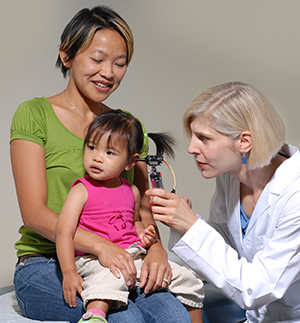After Tympanostomy (Ear Tubes)
You or your child has had ear tubes inserted. Once the tubes are in place, hearing should improve. For best results, follow up as instructed by your surgeon. In some cases, ear problems may continue. But you can help prevent ear infections by using good ear care.
Follow-up visit
-
Shortly after the surgery, the surgeon may want to examine you or your child. This follow-up visit ensures that the tubes are still in place and that the ears are healing.
-
After the initial follow-up, the healthcare provider may want to see you or your child every few months. Do your best to keep these visits. They’re the only way to make sure the tubes remain in place and stay open.
-
Most tubes stay in place for about a year. Some last longer. Most tubes fall out on their own. In rare cases, tubes need to be removed by the surgeon.

Fewer problems
-
Even with tubes, you or your child may still get ear infections. Irritability, ear drainage, and fever are all clues that you should call your healthcare provider. But as long as the tubes are working, you can expect fewer problems and a quicker recovery.
-
If an infection does happen, it will likely respond to antibiotic ear drops. For more severe infections, oral antibiotics may be added. Always make sure to finish the entire prescription, even if the symptoms go away. Otherwise, the medicine may not work. Use only ear drops prescribed by your provider.
Ear care
-
Ask your healthcare provider if you or your child’s ears should be protected from contact with water. You or your child may need to wear earplugs during swimming and bathing.
-
Don't use any ear drops, unless prescribed by the surgeon or another provider.
-
Don't use cotton swabs to clean the ears. Used improperly, they can clog tubes with wax or even damage the eardrum.
When to call your or your child's healthcare provider
Call your provider if you or your child has any of these signs:
-
Bloody drainage from the ears
-
Drainage from the ears that doesn't stop
-
Ear pain. Small children who can't tell you they are in pain may pull and rub their ears.
-
Any fever of 100.4°F (38°C) or higher, or as directed by your healthcare provider
-
Trouble hearing
-
Problems with balance
How to take a child's temperature
Use a digital thermometer to check your child’s temperature. Don’t use a mercury thermometer. There are different kinds and uses of digital thermometers. They include:
-
Rectal. For children younger than 3 years, a rectal temperature is the most accurate.
-
Forehead (temporal). This works for children age 3 months and older. If a child under 3 months old has signs of illness, this can be used for a first pass. The provider may want to confirm with a rectal temperature.
-
Ear (tympanic). Ear temperatures are accurate after 6 months of age, but not before.
-
Armpit (axillary). This is the least reliable but may be used for a first pass to check a child of any age with signs of illness. The provider may want to confirm with a rectal temperature.
-
Mouth (oral). Don’t use a thermometer in your child’s mouth until they are at least 4 years old.
Use the rectal thermometer with care. Follow the product maker’s directions for correct use. Insert it gently. Label it and make sure it’s not used in the mouth. It may pass on germs from the stool. If you don’t feel OK using a rectal thermometer, ask the healthcare provider what type to use instead. When you talk with any healthcare provider about your child’s fever, tell them which type you used.
Online Medical Reviewer:
Ashutosh Kacker MD
Online Medical Reviewer:
Marianne Fraser MSN RN
Online Medical Reviewer:
Tara Novick BSN MSN
Date Last Reviewed:
3/1/2022
© 2000-2025 The StayWell Company, LLC. All rights reserved. This information is not intended as a substitute for professional medical care. Always follow your healthcare professional's instructions.